
английский
.pdf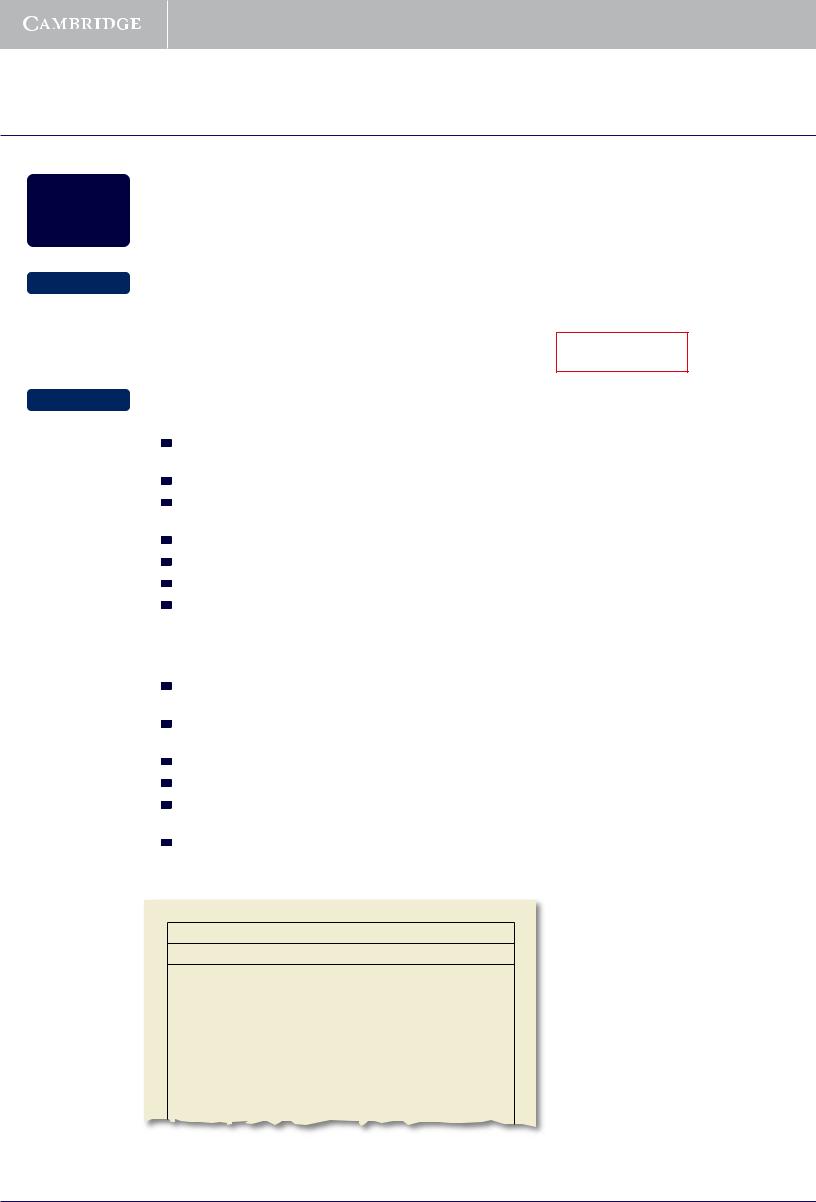
Cambridge University Press
978-0-521-61627-0 - Professional English in Use Finance
Ian MacKenzie Excerpt
More information
1 Money and income
ACurrency
The money used in a country – euros, dollars, yen, etc. – is its currency. Money in notes (banknotes) and coins is called cash. Most money, however, consists of
bank deposits: money that people and organizations have in bank accounts. Most of this is on paper – existing in theory only – and only about ten per cent of it exists in the form of cash in the bank.
BPersonal finance
All the money a person receives or earns as payment is his or her income. This can include:
a salary: money paid monthly by an employer, or wages: money paid by the day or the hour, usually received weekly
overtime: money received for working extra hours
commission: money paid to salespeople and agents – a certain percentage of the income the employee generates
a bonus: extra money given for meeting a target or for good financial results
fees: money paid to professional people such as lawyers and architects
social security: money paid by the government to unemployed and sick people
a pension: money paid by a company or the government to a retired person.
Salaries and wages are often paid after deductions such as social security charges and pension contributions.
Amounts of money that people have to spend regularly are outgoings. These often include:
living expenses: money spent on everyday needs such as food, clothes and public transport
bills: requests for the payment of money owed for services such as electricity, gas and telephone connections
rent: the money paid for the use of a house or flat
a mortgage: repayments of money borrowed to buy a house or flat
health insurance: financial protection against medical expenses for sickness or accidental injuries
A financial plan, showing how much money a person or |
BrE: social security; AmE: welfare |
organization expects to earn and spend is called a budget. |
BrE: flat; AmE: apartment |
|
|
Planned monthly budget for next year (€)
Income |
|
Outgoings |
|
|
|
|
|
Salary (after deductions) |
3,250 |
Rent |
900 |
|
|
|
|
Commission (average) |
600 |
Bills |
250 |
|
|
|
|
|
|
Living expenses |
1,200 |
|
|
|
|
|
|
Health insurance |
130 |
|
|
|
|
|
|
Tax |
800 |
|
|
|
|
Total |
3,850 |
Total |
3,280 |
|
|
|
|
Professional English in Use Finance
© Cambridge University Press |
www.cambridge.org |
|
|
|
|
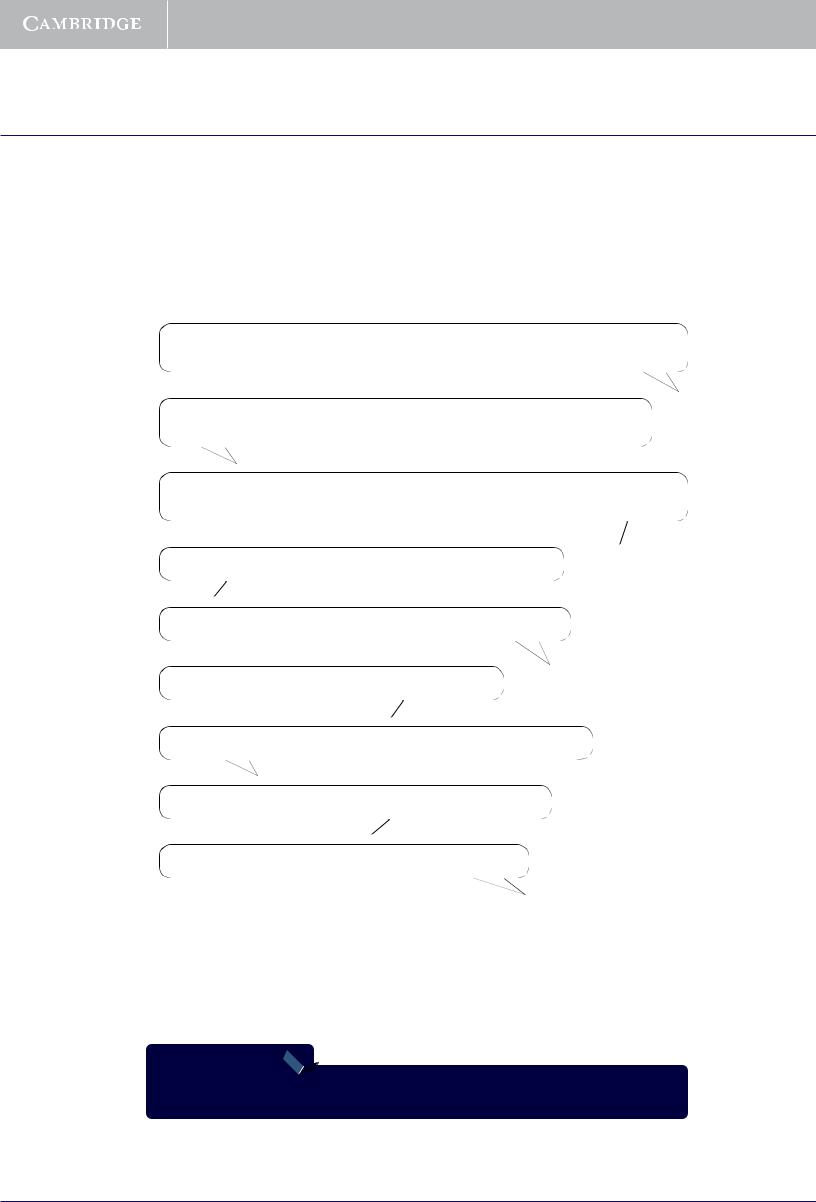
Cambridge University Press
978-0-521-61627-0 - Professional English in Use Finance
Ian MacKenzie Excerpt
More information
1.1Complete the sentences with words from the box. Look at A and B opposite to help you.
commission |
bonus |
currency |
|
earn |
mortgage |
tax |
overtime |
pension |
rent |
|
salary |
social security |
|
|
|
|
|
|
|
|
1 |
|
|
|
for three months. This was difficult, |
||
After I lost my job, I was living on ........................ |
|
|||||
because the amount was much lower than the |
........................ |
I had before. |
|
|||
2 |
|
|
|
|
|
|
I used to work as a salesperson, but I wasn’t very successful, so I didn’t |
........................ |
|||||
much ........................ |
. |
|
|
|
|
|
3 |
|
|
|
|
|
at the end of |
If the company makes 10% more than last year, we’ll all get a ........................ |
||||||
the year. |
|
|
|
|
|
|
4 |
|
|
|
on my house. |
|
|
It’ll take me at least 25 years to repay the ........................ |
|
|
||||
5 |
|
|
|
|
, the euro. |
|
Many European countries now have the same |
........................ |
|
||||
6 |
|
|
|
|
|
|
My wages aren’t very good, so I do a lot of ........................ |
|
. |
|
|
||
7 |
|
|
|
|
|
|
Nearly 40% of everything I earn goes to the government as ........................ . |
|
|||||
8 |
|
|
on our flat by 15%. |
|
||
The owner has just increased the ........................ |
|
|||||
9 |
|
will be 60% of my final salary. |
|
|||
When I retire, my ........................ |
|
|||||
1.2Are the following statements true or false? Find reasons for your answers in A and B
Over to you 
Do you know what the average income is in your country, and in your job, or the one you are studying for? How important is salary in your choice of career?
Professional English in Use Finance |
9 |
© Cambridge University Press |
www.cambridge.org |
|
|
|
|
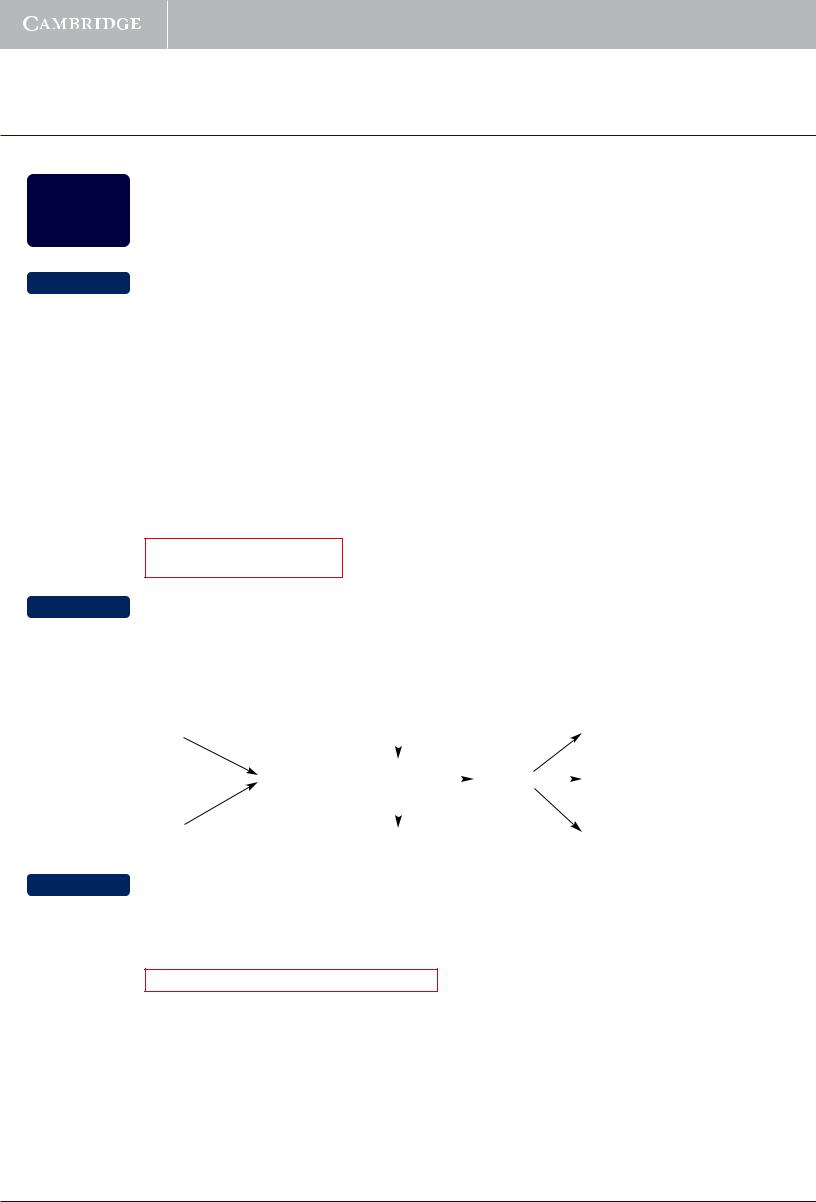
Cambridge University Press
978-0-521-61627-0 - Professional English in Use Finance
Ian MacKenzie Excerpt
More information
2 Business finance
A
When people want to set up or start a company, they need money, called capital. Companies can borrow this money, called a loan, from banks. The loan must be paid back with interest: the amount paid to borrow the money. Capital can also come from issuing shares or equities – certificates representing units of ownership of a company. (See Unit 29) The people who invest money in shares are called shareholders and they own part of the company. The money they provide is known as share capital. Individuals and financial institutions, called investors, can also lend money to companies by buying bonds
– loans that pay interest and are repaid at a fixed future date. (See Unit 33)
Money that is owed – that will have to be paid – to other people or businesses is a debt. In accounting, companies’ debts are usually called liabilities. Long-term liabilities include bonds; short-term liabilities include debts to suppliers who provide goods or services on credit – that will be paid for later.
The money that a business uses for everyday expenses or has available for spending is called working capital or funds.
BrE: shares; AmE: stocks
BrE: shareholder; AmE: stockholder
BRevenue
All the money coming into a company during a given period is revenue. Revenue minus the cost of sales and operating expenses, such as rent and salaries, is known as profit, earnings or net income. The part of its profit that a company pays to its shareholders is a dividend. Companies pay a proportion of their profits to the government as tax, to finance government spending. They also retain, or keep, some of their earnings for future use.
share capital |
|
revenue |
|
|
|
|
|
|
dividends |
||
|
|
|
|
|
|
|
|
|
|
|
|
|
|
|
|
|
|
|
|
|
|
|
|
|
capital |
|
company |
|
|
|
profits |
|
|
tax |
|
|
|
|
|
|
|
|
|||||
|
|
|
|
|
|
|
|
|
|
|
|
|
|
|
|
|
|
|
|
|
|
||
|
|
|
|
|
|
|
|
|
|
|
|
debt (bonds and loans) |
|
expenses |
|
|
|
|
|
|
retained earnings |
||
CFinancial statements
Companies give information about their financial situation in financial statements. The balance sheet shows the company’s assets – the things it owns; its liabilities – the money it owes; and its capital. The profit and loss account shows the company’s revenues and expenses during a particular period, such as three months or a year.
BrE: profit and loss account; AmE: income statement
Professional English in Use Finance
© Cambridge University Press |
www.cambridge.org |
|
|
|
|
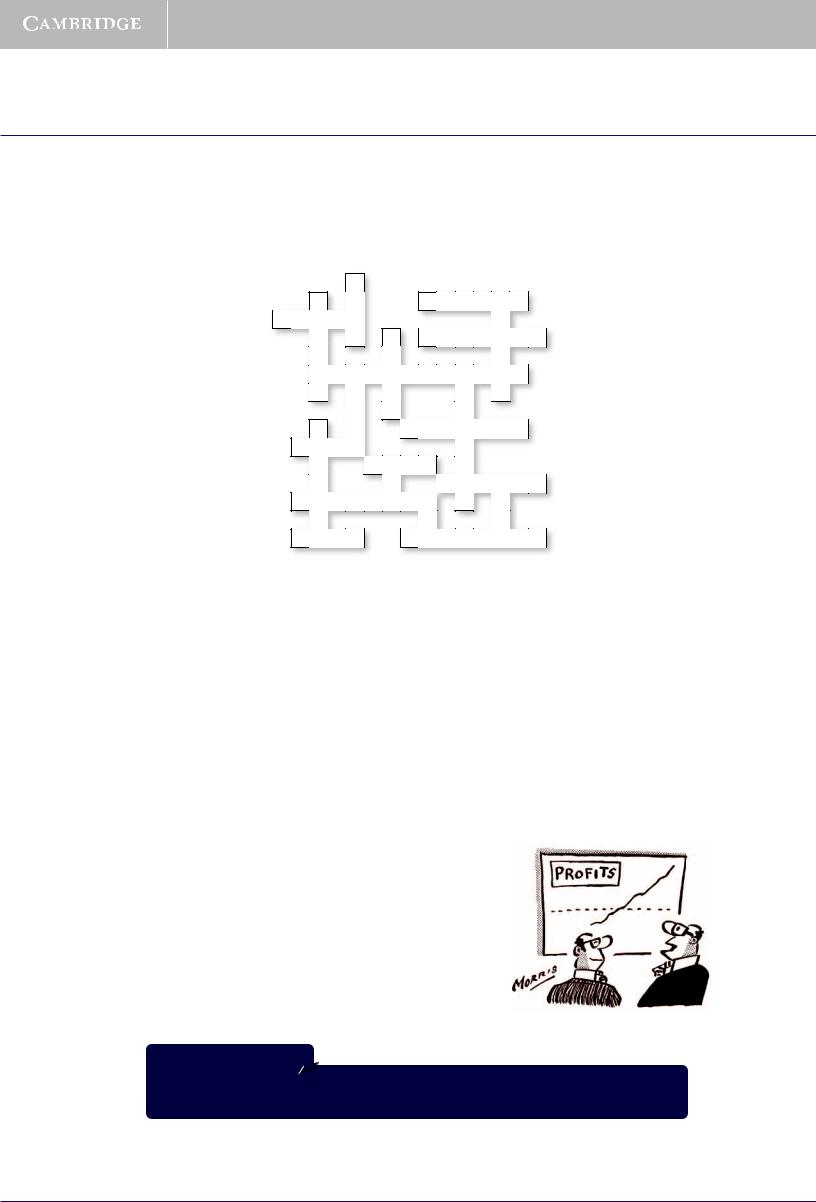
Cambridge University Press
978-0-521-61627-0 - Professional English in Use Finance
Ian MacKenzie Excerpt
More information
2.1Complete the crossword. Look at A, B and C opposite to help you.
|
1 |
|
|
|
2 |
|
|
3 |
4 |
5 |
|
|
|
|
|
|
6 |
7 |
|
8 |
9 |
|
|
10 |
11 |
|
|
12 |
|
13 |
|
|
|
|
|
14 |
15 |
|
|
|
|
|
16 |
17 |
18 |
|
|
19 |
|
20 |
|
|
21 |
|
“It’s been a great year – let’s hope we can
Over to you 

keep the shareholders from finding out.”
Think of the company you work for, or one that you are interested in. How was it financed when it was set up, and how is it financed now?
Professional English in Use Finance |
11 |
© Cambridge University Press |
www.cambridge.org |
|
|
|
|
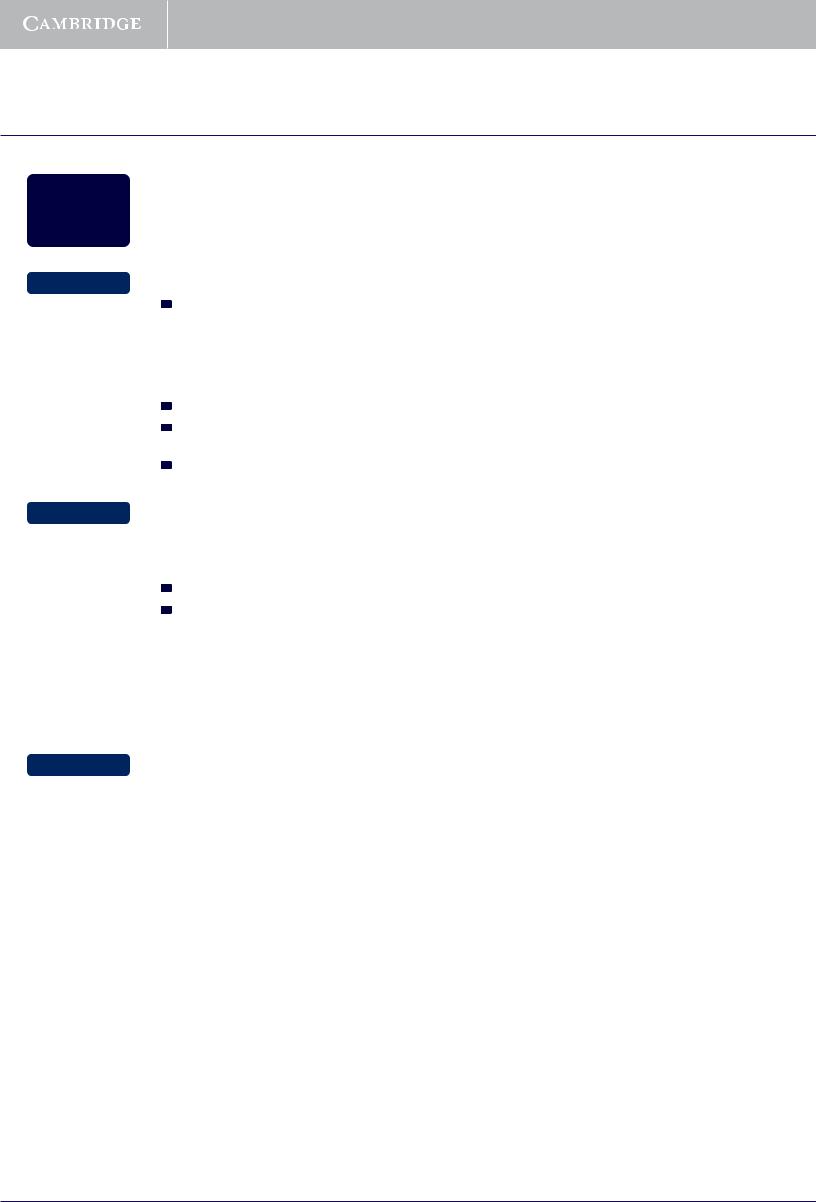
Cambridge University Press
978-0-521-61627-0 - Professional English in Use Finance
Ian MacKenzie Excerpt
More information
3 Accounting and accountancy
AAccounting
Accounting involves recording and summarizing an organization’s transactions or business deals, such as purchases and sales, and reporting them in the form of financial statements. (See Units 11–14) In many countries, the accounting or accountancy profession has professional organizations which operate their own training and examination systems, and make technical and ethical rules: these relate to accepted ways of doing things.
Bookkeeping is the day-to-day recording of transactions.
Financial accounting includes bookkeeping, and preparing financial statements for shareholders and creditors (people or organizations who have lent money to a company).
Management accounting involves the use of accounting data by managers, for making plans and decisions.
BAuditing
Auditing means examining a company’s systems of control and the accuracy or exactness of its records, looking for errors or possible fraud: where the company may have deliberately given false information.
An internal audit is carried out by a company’s own accountants or internal auditors.
|
company. |
The |
audit examines the truth and fairness of financial statements. It tries to prevent |
what is called ‘creative accounting’, which means recording transactions and values in a way that a false result – usually an artificially high profit.
There is always more than one way of presenting accounts. The accounts of British companies have to give a true and fair view of their financial situation. This means that the financial statements must give a correct and reasonable picture of the company’s current condition.
CLaws, rules and standards
In most continental European countries, and in Japan, there are laws relating to accounting, established by the government. In the US, companies whose stocks are traded on public stock exchanges have to follow rules set by the Securities and Exchange Commission (SEC), a government agency. In Britain, the rules, which are called standards, have been established by independent organizations such as the Accounting Standards Board (ASB), and by the accountancy profession itself. Companies are expected to apply or use these standards in their annual accounts in order to give a true and fair view.
Companies in most English-speaking countries are largely funded by shareholders, both
ind iduals and financial institutions. In these countries, the financial statements are prepared for shareholders. However, in many continental European countries businesses are largely funded by banks, so accounting and financial statements are prepared for creditors and the tax authorities.
Professional English in Use Finance
© Cambridge University Press |
www.cambridge.org |
|
|
|
|
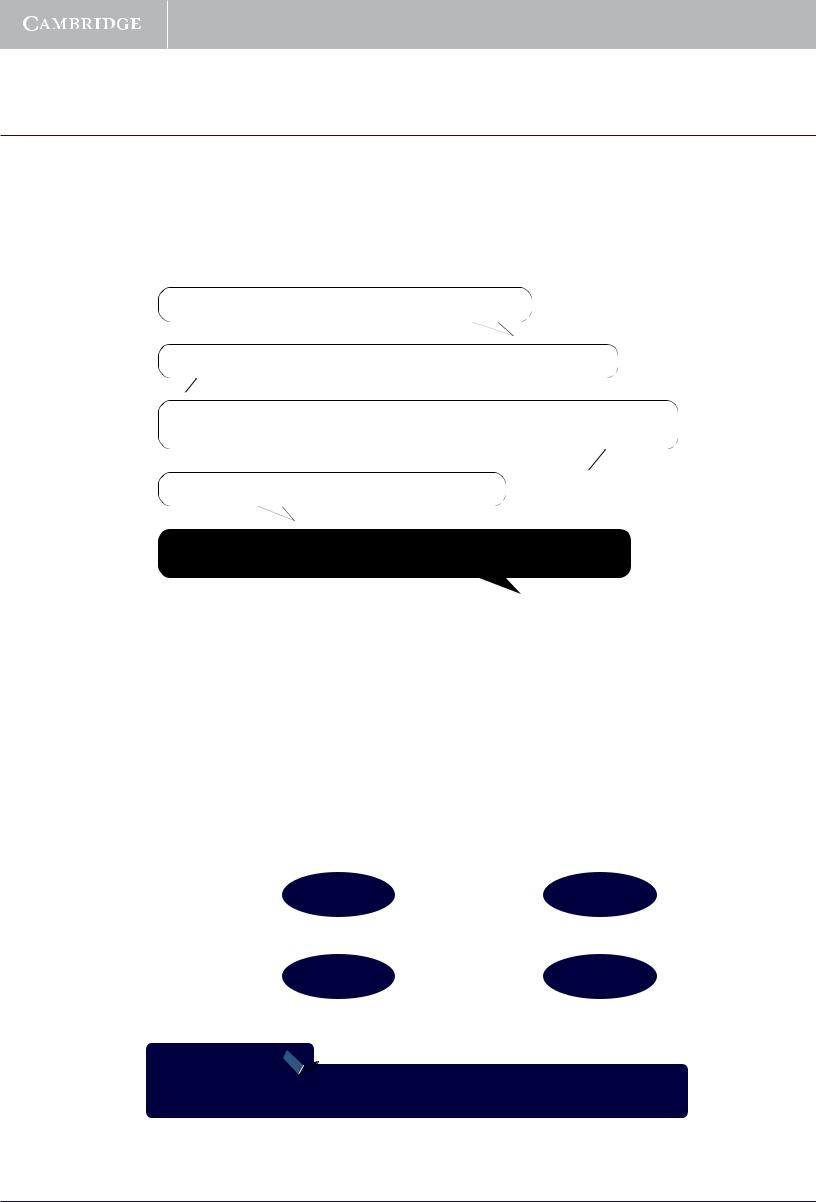
Cambridge University Press
978-0-521-61627-0 - Professional English in Use Finance
Ian MacKenzie Excerpt
More information
3.1What type of work does each person do, and what is the name of each job? Look at A and B opposite to help you.
1
I record all the purchases and sales made by this department.
2
This month, I’m examining the accounts of a large manufacturing company.
3
I analyse the sales figures from the different departments and make decisions about our future activities.
4
I am responsible for preparing our annual balance sheet.
5
When the accounts are complete, I check them before they are presented to the external auditors.
3.2
3.3
Match the two parts of the sentences. Look at C opposite to help you.
1 In Britain
2 In most of continental Europe and Japan 3 In the USA
4 In Britain and the USA
5 In much of continental Europe
a accounting rules are established by a government agency.
b companies are mainly funded by shareholders or stockholders. c accounting rules are set by an independent organization.
d the major source of corporate finance is banks. e accounting rules are set by the government.
Find verbs in A, B and C opposite that can be used to make word combinations with the
...............................
...............................
...............................
...............................
...............................
...............................
an audit
rules
...............................
...............................
...............................
...............................
...............................
standards
transactions
Over to you 
Is accounting in your country based on standards, rules, laws, or a mixture of these? What accounting system do international companies in your country use?
Professional English in Use Finance |
13 |
© Cambridge University Press |
www.cambridge.org |
|
|
|
|
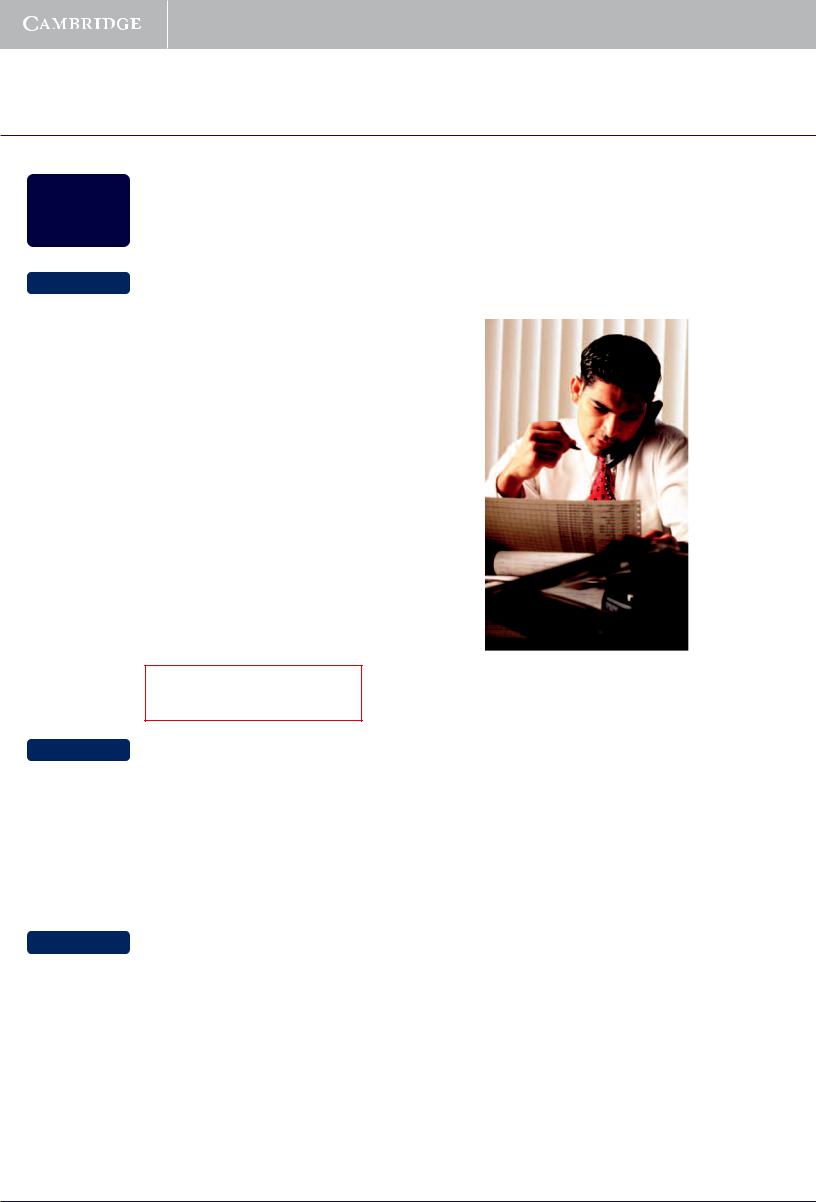
Cambridge University Press
978-0-521-61627-0 - Professional English in Use Finance
Ian MacKenzie Excerpt
More information
4 Bookkeeping
A
Zaheer Younis works in the accounting department of a trading company:
‘I began my career as a bookkeeper. Bookkeepers record the company’s daily transactions: sales, purchases, debts, expenses, and so on. Each type of transaction is recorded in a separate account – the cash account, the liabilities account, and so on. Double-entry bookkeeping is a system that records two aspects of every transaction. Every transaction is both a debit – a deduction – in one account and a corresponding credit – an addition – in another. For example, if a company buys some raw materials – the substances and components used to make products – that it will pay for a month later, it debits its purchases account and credits the supplier’s account. If the company sells an item on credit, it credits the sales account, and debits the customer’s account. As this means the level of the company’s stock – goods ready for sale – is reduced, it debits the stock account. There is a corresponding increase in its debtors – customers who owe money for goods or services purchased – and the debtors or accounts payable account is credited. Each account records debits on the left and credits on the right. If the bookkeepers do their work correctly, the total debits always equal the total credits.’
BrE: debtors; AmE: accounts receivable
BrE: creditors; AmE: accounts payable
BrE: stock; AmE: inventory
BDay books and ledgers
‘For accounts with a large number of transactions, like purchases and sales, companies often record the transactions in day books or journals, and then put a daily or weekly summary in the main double-entry records.
In Britain, they call the main books of account nominal ledgers. Creditors – suppliers to whom the company owes money for purchases made on credit – are recorded in a bought ledger. They still use these names, even though these days all the information is on a computer.’
Note: In Britain the terms debtors and creditors can refer to people or companies that owe or are owed money, or to the sums of money in an account or balance sheet.
CBalancing the books
‘At the end of an accounting period, for example a year, bookkeepers prepare a trial balance which transfers the debit and credit balances of different accounts onto one page. As always, the total debits should equal the total credits. The accountants can then use these balances to prepare the organization’s financial statements.’
Professional English in Use Finance
© Cambridge University Press |
www.cambridge.org |
|
|
|
|
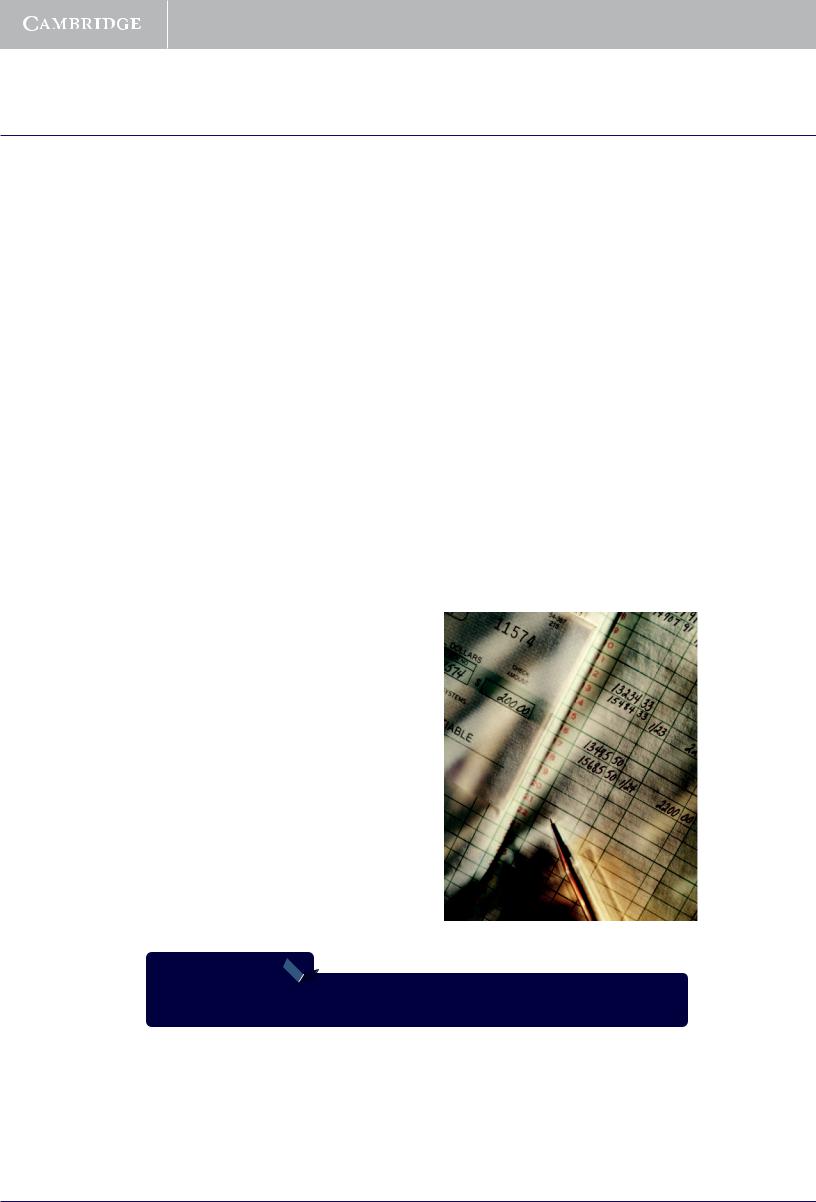
Cambridge University Press
978-0-521-61627-0 - Professional English in Use Finance
Ian MacKenzie Excerpt
More information
4.1
4.2
4.3
Match the words in the box with the definitions below. Look at A and B opposite to help you.
|
credit |
ledger |
debit |
|
|
creditors |
stock |
debtors |
|
|
|
|
||
1 |
an amount entered on the left-hand side of an account, recording money paid out |
|||
2 |
a book of accounts |
|
|
|
3 |
customers who owe money for goods or services not yet paid for |
|||
4 |
an amount entered on the right-hand side of an account, recording a payment received |
|||
5 |
goods stored ready for sale |
|
|
|
6 |
suppliers who are owed money for purchases not yet paid for |
|||
Complete the sentences. Look at A, B and C opposite to help you.
1 |
............................ ............................ |
shows where money comes from and where it goes: it is always |
|
|
transferred from one ............................ |
to another one. Every event is entered twice – once as a |
|
|
credit and once as a ............................ |
. |
|
2 |
Most businesses record very frequent or numerous transactions in ............................ ............................ |
||
|
or ............................ . |
|
|
3 |
The main account books are called ............................ ............................ |
, and the book relating to |
|
|
creditors is called the ............................ |
............................ . |
|
4 |
In order to prepare financial statements, companies do a ............................ |
............................ which |
|
copies all the debit and credit balances of different accounts onto a single page.
Complete the sentences using ‘debit’ or ‘credit’.
Over to you 
What qualities does a good bookkeeper need? Would you like to work as a bookkeeper? If not, which type of accounting do you think is the most interesting, and why?
Professional English in Use Finance |
15 |
© Cambridge University Press |
www.cambridge.org |
|
|
|
|

Cambridge University Press
978-0-521-61627-0 - Professional English in Use Finance
Ian MacKenzie Excerpt
More information
5 Company law 1
APartnerships
A partnership is a business arrangement in which several people work together, and share the risks and profits. In Britain and the US, partnerships do not have limited liability for debts, so the partners are fully liable or responsible for any debts the business has. Furthermore, partnerships are not legal entities, so in case of a legal action, it is the individual partners and not the partnership that is taken to court. In most continental European countries there are various kinds of partnership which are legal entities.
A sole trader business – an enterprise owned and operated by a single person – also has unlimited liability for debts.
BLimited liability
A company is a business that is a legal entity. In other words, it has a separate legal existence from its owners, the shareholders. It can enter into contracts, and can be sued or taken to court if it breaks a contract. A company can (in theory) continue for ever, even if all the staff and owners change. Most companies have limited liability, which means that the owners are not fully liable for – or responsible for – the business’s debts. These companies are known as limited companies. Their liability is limited to the value of their share capital: the amount of cash that the shareholders have contributed to the company. This limitation of liability encourages investors to risk their money to become part owners of companies, while leaving the management of these companies to qualified managers and senior managers, known as directors.
These managers and full-time executive directors run the company for its owners. There are standard procedures of corporate governance – the way a company is run by the management for the shareholders, and how the managers are accountable to the shareholders. These include separating the job of chairman from that of managing director, and having several non-executive directors on the board of directors who do not work full-time for the company but can offer it expert advice. Non-executive directors are often more objective: less influenced by their opinions and beliefs. There is also an audit committee, containing several non-executive directors, to which the auditors report.
BrE: chairman; AmE: president
BrE: managing director; AmE: chief executive officer (CEO)
CFounding companies
When people found or start companies, they draw up or prepare Articles of Association and a Memorandum of Association. The Articles of Association state:
the rights and duties of the shareholders and directors
the relationships among different classes of shareholder (See Unit 29)
the relationships between shareholders and the company and its directors.
The Memorandum of Association states:
the company’s name
the location of the company’s registered office – where to send official documents
the company’s purpose – its aims or objectives
BrE: Articles of Association; AmE: Bylaws
BrE: Memorandum of Association; AmE: Certificate of Incorporation
Professional English in Use Finance
© Cambridge University Press |
www.cambridge.org |
|
|
|
|

Cambridge University Press
978-0-521-61627-0 - Professional English in Use Finance
Ian MacKenzie Excerpt
More information
5.1Are the following statements true or false? Find reasons for your answers in A and B opposite.
1 In case of a legal dispute, people can take a company’s shareholders to court. 2 The owners of limited companies have to pay all the company’s debts.
3 Many companies are not owned by their managers.
4 External directors can usually give more objective advice than full-time directors.
5 Partners in British and American businesses are not liable for the partnership’s debts. 6 In case of a dispute, people can take British companies and partnerships to court.
5.2Make word combinations using a word from each box. Then match the word combinations to the definitions below. Look at A opposite to help you.
corporate |
|
|
committee |
|
audit |
|
|
directors |
|
limited |
|
|
governance |
|
non-executive |
|
|
capital |
|
share |
|
|
liability |
|
|
|
|
|
|
1 ............................ ............................ |
|
: a group of directors to whom the external auditors present |
||
their report |
|
|
|
|
2 ............................ ............................ |
|
: members of a board of directors who are not full-time managers |
||
of the company |
|
|
|
|
3 ............................ ............................ |
|
: owners’ money invested in a company |
||
4 ............................ ............................ |
|
: responsibility for debts up to the value of the company’s |
||
share capital |
|
|
|
|
5 ............................ ............................ |
|
: the way a company is managed for its owners |
||
5.3Complete the document. Look at C opposite to help you.
Over to you 
Do partnerships have limited liability in your country? If not, who would you trust enough to start a partnership with?
Professional English in Use Finance |
17 |
© Cambridge University Press |
www.cambridge.org |
|
|
|
|
